Buried Metal Stories
Forum members swap stories of finding metal in the heart of a sawlog — and even in plywood. October 17, 2012
Forum Responses
(Sawing and Drying Forum)
From contributor E:
I had just started sawing in 1994 with my new Timberking 1600 when a friend wanted two cedar logs sawn. I sawed the eight foot butt cut with no problem and started the top eight foot cut which had been cut off at a fork in the tree. It looked like everything was going along fine when I was taking the second slab cut off. As the blade entered the forked area the engine suddenly died with an awful noise from the blade. After getting the toothless blade out of the cut I took a chainsaw and cut near the point where the blade stopped. After a few strokes with an axe I saw the culprit, a two piece magnet the size of a quarter 2" long had been lodged in the fork and the tree had grown around it. Still till this day I have not figured out how a magnet had made it 16' up a cedar tree!
From Gene Wengert, forum technical advisor:
This is not a buried metal story, but is close. One day, a group of Boy Scouts asked for permission to visit the mill and see it in action. We made sure they wore safety glasses, ear plugs, and had them in a safe location. The regular sawyer had gone home, so I was the sawyer. We had a nice yellow poplar log on the carriage that had been sitting around for a while, and after talking to the kids about "Is it ok to cut a tree and saw a log?", I started to saw. This is on a Carley mill with a 56" diameter circle saw and 75 hp motor. About the second or third cut (I was sawing a bit too fast perhaps) the blade got a bit hot at the edge and started to wobble and all of a sudden, the blade moved enough on the back side to scrape the edge of the head blocks on the carriage and send up a shower of sparks. The kids loved it, but the next morning the regular sawyer was not too happy having to change a dozen or so inserted teeth.
From contributor B:
My story doesn’t involve metal in logs either although I have found a few nails. Most of my sawing is done on my own logs and I have a pretty good idea which ones might be suspect. Occasionally I saw for others and on this occasion a friend had delivered some nice oak logs with the ends painted. Being as the logs were short I sawed through the paint, each time the blade entered the log sparks would fly. Three new blades in three short logs and then the rest of the logs became a little shorter as I cut a cookie off each end and sawed the last three with one band no sparks. Come to find out the paint had been water proofing paint like you’d paint a basement wall with. Moral of the story, it’s not always what is hidden that ruins your day.
From contributor H:
I had more nails than a beauty salon! I acquired seven very unique pine timbers last winter about 12" in diameter and 16' long - talk about old growth pine.They were used in a Grist Mill around Franklinton, Louisiana in about 1880. Part of the mill burned down in the early 1900's. The part that did not burn fell into the creek that was the power source for the Grist grinding wheels. Last year they found those timbers buried under two feet of sand and water in the creek. (I assumed that is what preserved the wood) and they found one of the mill stones too. So, I was asked to mill the timbers. You can see the hand work that was done on them those many years ago.
But, they had nails then too! These are all the nails I found, one way or another. Most I was able to pull. I got lucky and found stain marks as I slabbed the timber and was able to get some nails out before the band blade hit it, but it did ruin three blades total. Those nails are the old fashion kind - they're square! It wasn't just a ruined day, it was three ruined days. That's how long it took to work those timbers. But the history behind them continues to play in my mind still.
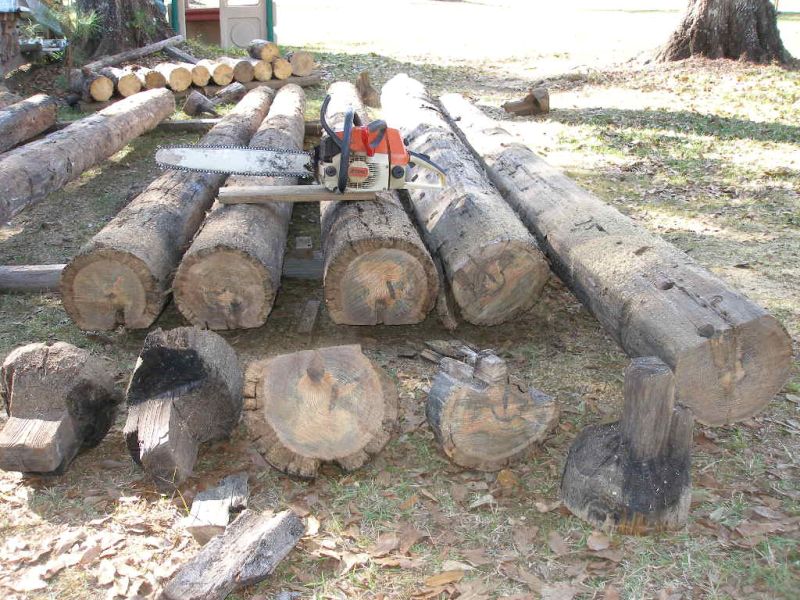
Click here for higher quality, full size image
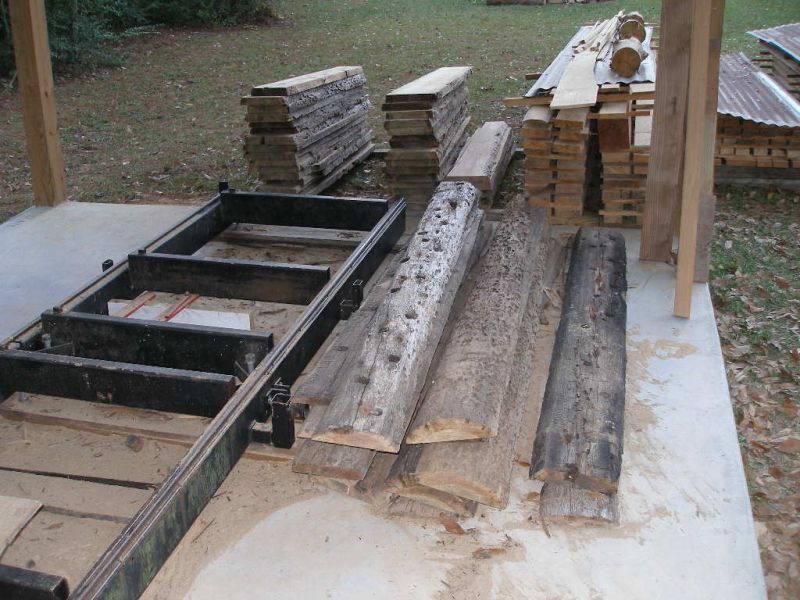
Click here for higher quality, full size image
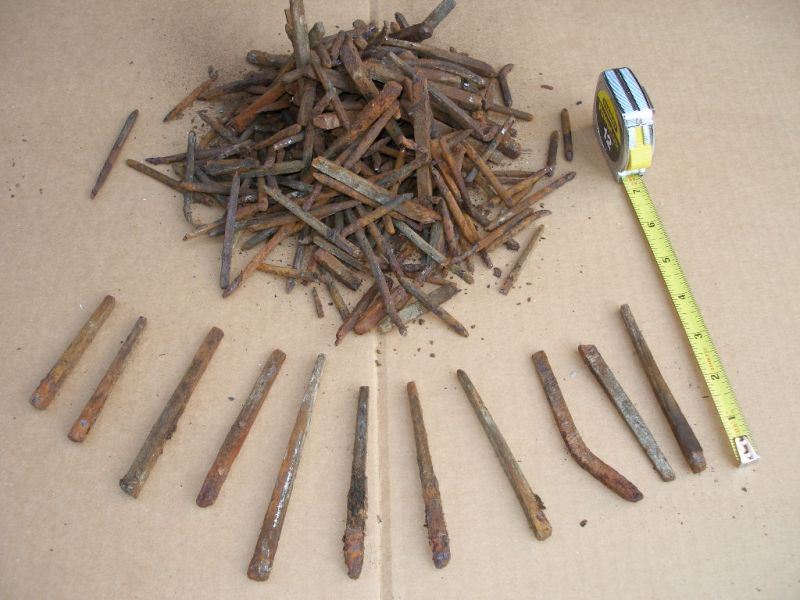
Click here for higher quality, full size image
From contributor G:
I had accepted a set of logs to be sold as lumber cut on my mill. The logs looked great - Douglas fir, 22” at the small end, straight, and very few small knots. The perfect order came along, beams to make an outside covered space. The job went well and I was down to my last log, just some 8x8” 20 footers and I hit something in my first cut after making the cant. The object was not that large but enough to dull the saw blade. We have all hit nails and while you get used to the sound they make this sounded a bit bigger. Then bam, I hit something really hard and wow did the saw scream! I think I screamed too, perhaps even louder! The picture below shows the second collision of a ceramic insulator and its steel screw; note the saw teeth are all rolled over. I sure could have used a metal detector that day!
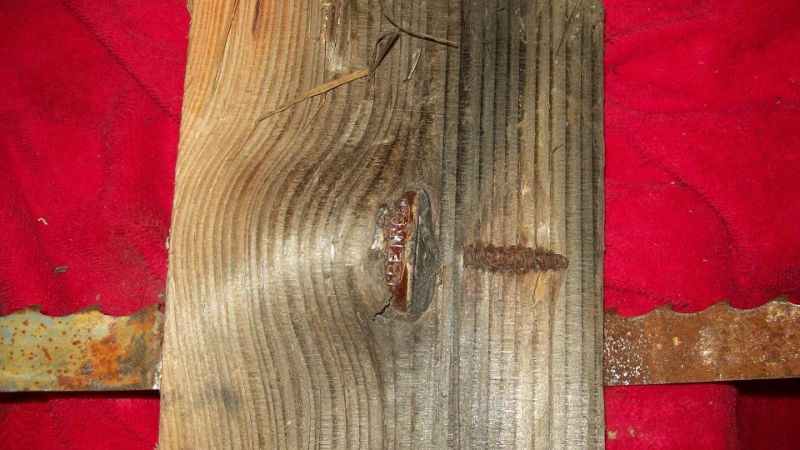
Click here for higher quality, full size image
From contributor K:
Some years ago I was ripping some nice S2S kiln-dried red oak boards into face frame parts. As I was stacking some of the pieces I noticed something odd looking on two of the newly-cut edges. They were the two halves of a copper-jacketed bullet. Someone years ago had shot the tree and the wood grew around that bullet perfectly, sealing it inside. It was pretty well deformed but the copper jacketing and lump of lead was obvious since I had cut a perfect cross section. Fortunately the blade didn't even notice what it had cut through so my day wasn't ruined. I couldn't tell what caliber it was but it was a sizeable chunk - about the size of an unshelled almond.
From contributor R:
A fellow and myself were working on a five foot diameter California Valley oak with our twin Husky Alaskan Mill. On the forth slab near the pith, as we exited the crotch, sparks flew. We dug into the crotch with a small saw and found the metal. It was a blue and yellow Farm Bureau sign that read "$75.00 Reward For Chicken Thieves". Apparently people took stealing chickens seriously in the early 20th century! I still have the sign (what’s left of it) in the shop, and it makes me laugh each time I look at it.
From contributor T:
I was lucky as I only edged this bullet below on the butt while sawing walnut. I saw the spot and dug this out – it was close! I would've ruined/dulled a new blade.
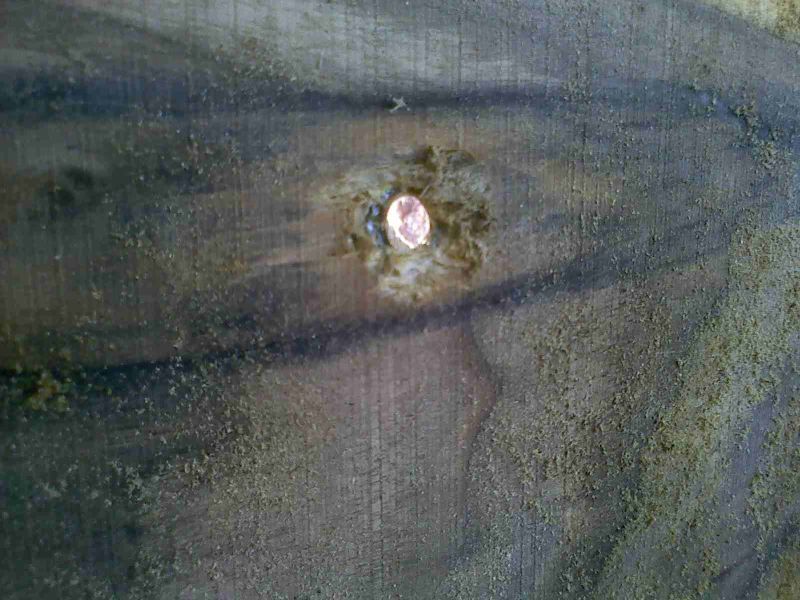
Click here for higher quality, full size image
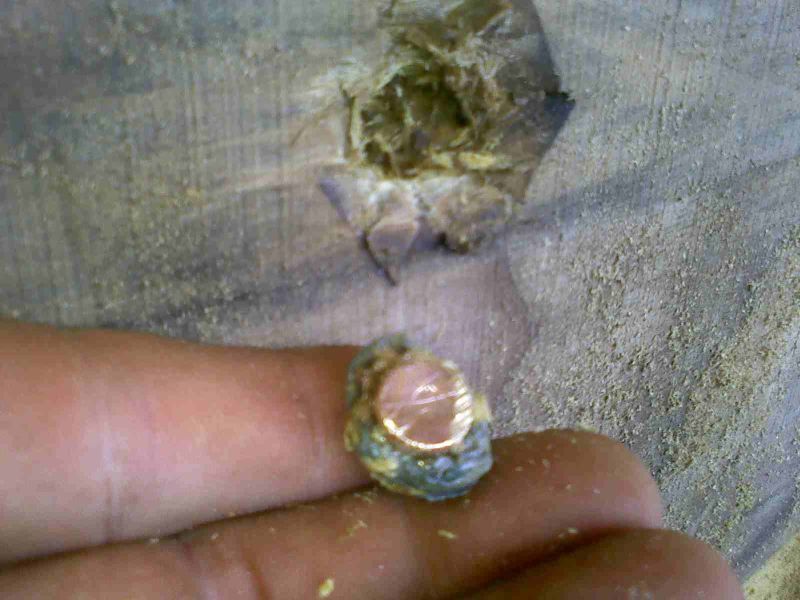
Click here for higher quality, full size image
From contributor U:
I actually did not hit the metal "T" post buried in the tree below because half of it was sticking out and visible, but my day was almost ruined by something else. In the pictures below you will notice the nice large sycamore tree I am about to fell. There was a "T" post next to the tree that the base of the tree had grown around. I bent it back and forth until I broke the top off so I could cut more of the trunk. I was more concerned about hitting the remaining "T" post with my saw than with the danger that lurked unnoticed above me. Shortly after the tree hit the ground I noticed a "cloud" beginning to form over this large limb that had split, and shortly thereafter I split too! I had been a hobby beekeeper in years past so I still had my veil and gloves. After retrieving and donning them I was able to finish getting the log without getting stung.
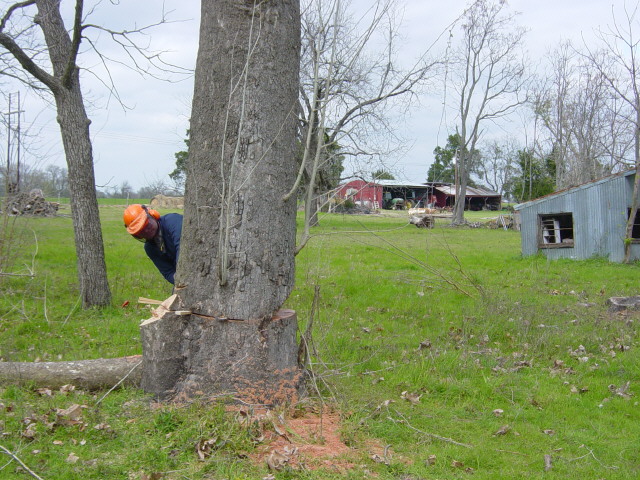
Click here for higher quality, full size image
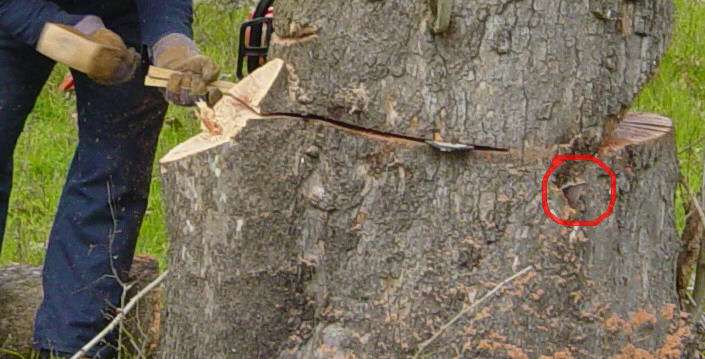
Click here for higher quality, full size image
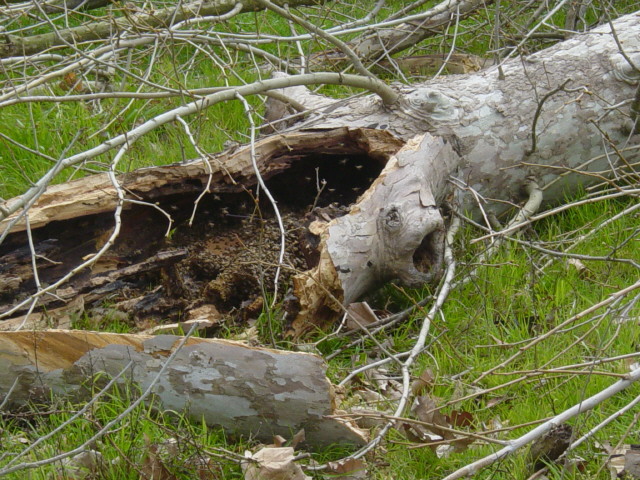
Click here for higher quality, full size image
From contributor C:
Did buried metal ruin our day? I'll let you be the judge. All I know is that somebody at the plywood plant is missing his metal putty knife! We lost a sawblade that day, but gained an interesting souvenir!

Click here for higher quality, full size image
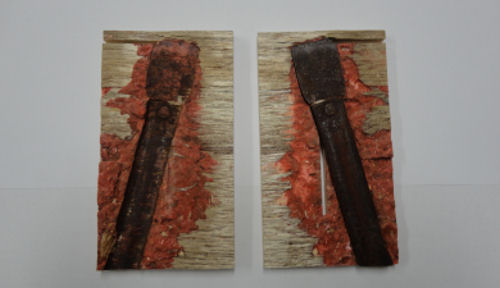
Click here for higher quality, full size image
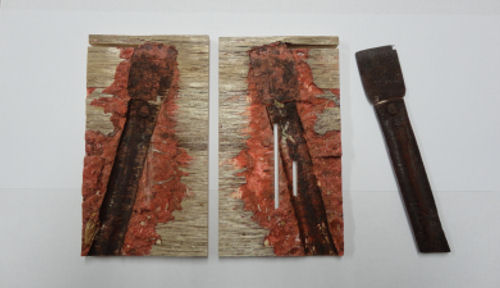
Click here for higher quality, full size image
From contributor U:
While sawing a 20" pecan log on my Logosol mill (Stihl 066 with a 25" bar) back in 2003 I felt a sudden jerky vibration in the saw and felt a sting on my arm. I noticed a small shiny object lying on the mill's beam and realized it was the top of a tooth. I examined the chain and found nine teeth either sheared off or bent. After installing a new chain I backed into the log from the other end (one of the few advantages of the chainsaw mill over the band mill) and stopped short of whatever I had hit and broke the board off to discover that some kid had driven about a dozen nails through an old lug nut into the tree about 50 years prior.
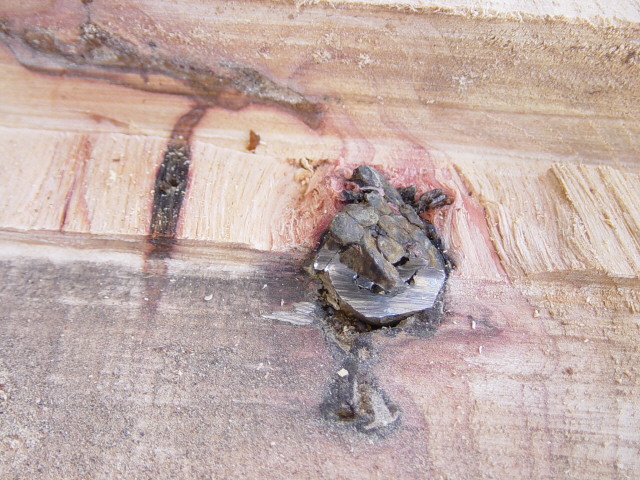
Click here for higher quality, full size image
From contributor A:
I wanted my first woodworking project to be of reclaimed oak lumber from an old barn. After hours of walking through fields containing piles of this old wood, I finally picked a beast of a log to get sliced up. The guy who I was buying the log from offered to take it to a mill down the road with his front-end loader and I could come back to pick it up the following week. He quoted me $40 for his hassle and gave me a $50 estimate to get the log sliced up. Seven days later, when he handed me the bill from the mill, the handwritten invoice had a line item for sharpening seven blades with a baggie containing square nails. Most expensive wood I ever bought.
From contributor J:
I have a LT40 SH for personal use and will cut for others. I had a pine tree delivered for milling with bhd of 33". In AL pine does not get that large without a reason, but it was a country tree, the biggest I'll ever mill. I milled the upper logs first, beautiful lumber. I did learn about the mental stress of large diameter logs. I would see one of the fleches and think I missed a one by ten only to turn it over.
The butt log was 14 feet long and was maneuvered by a 640 Ford tractor to mill first thing in the morning. With fear and caution I loaded the log on the mill, the dogs looked like pups. I started milling the cant; all was well. The cant was 28 inches, clear, no runout. On the next cut the saw blade started diving. I pulled back and replaced the blade, and continued the cut and went about one foot further and hit another nail. I say nail because only four to five teeth show metal damage.
I put in a new blade, started another cut two inches below, and hit metal. As the morning passed, no blade would proceed more than a foot or so into the log. It was a bad day when I realized I was not going to saw the log away. I had nothing capable of removing the cant from the mill. Finding no way to slide the cant onto the loading arms I went at it with a chainsaw, promptly ruining the chains. It would seem that the log is full of nails and can't be milled. I was able to saw though the cant eight feet below the top leaving six foot of the broad and nail riddled base. The tractor did lift the six foot cant off and it is now a yard ornament. The top eight feet did not have as many nails and I was able to mill it off. I lost a day, milled very little lumber, and gained a conversation piece for the yard.












